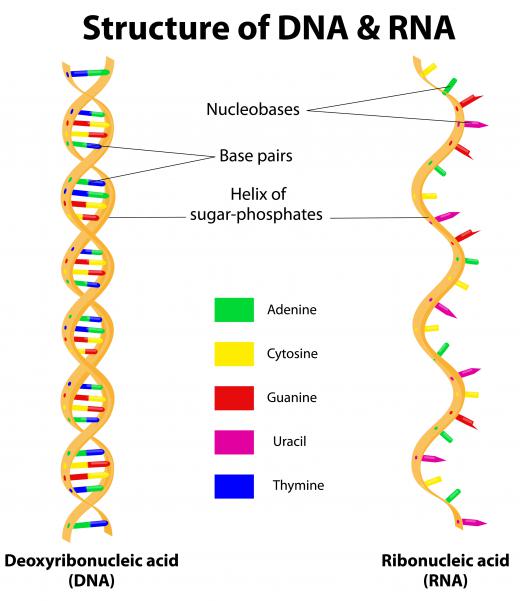What Is a RNA Polymerase?
Deoxyribonucleic acid (DNA) carries all of the genetic information every living thing needs to grow and survive. The detailed information contained in the molecule is transported within cells via ribonucleic acid (RNA). There are different types of RNA but all of them need to be transcribed by an enzyme called RNA polymerase. Once it surrounds the structure of the DNA, the enzyme uncoils the double helical structure and makes copies of the genetic information. The polymerase is a complex structure called a holoenzyme and performs functions such as uncoiling DNA, recombining the two sides at the end of the process, while copying genes and fixing errors in between.
Single-celled organisms like bacteria have one form of RNA polymerase. Multi-cellular organisms, from yeast to humans, have three kinds. The first type transcribes ribosomal RNA (rRNA), which has all the information for making proteins in a cell’s ribosome. Messenger RNA (mRNA), for building proteins needed for different cellular functions, is created by genetic material processed by RNA polymerase II. The third polymerase is assigned to transfer RNA (tRNA), a molecule that adds amino acids to chains of proteins called polypeptides.

Without RNA polymerase, the information encoded in DNA could not be copied and encoded properly. The enzyme creates each one of the many different kinds of ribonucleic acid in the body, while it travels down the DNA molecule. It begins transcription by binding to a structure called a promoter, where a gene starts. Promoters are DNA sequences that enable the enzyme to bond to a gene and activate. When the copying starts, the transcript initially elongates to clear away the promoter gene so the enzyme can continue on.
Thousands of nucleotides make up each gene, so RNA polymerase is also built to catch and fix errors. The enzyme removes incorrect nucleotides as it travels and also adds the correct ones. It can slow down and even stop to make fixes if proteins are not matched the way they should be.
The structure and function of RNA polymerase is vulnerable to various toxins. Some mushroom poisons block the movement of the enzyme and cause it to stop working. This can kill a person within days, since every function in the body is dependent on a process resulting from the consistent coding of RNA. Every living organism contains RNA polymerase, which serves the same purpose regardless of the similarities and differences between individual cells.
AS FEATURED ON:
AS FEATURED ON:











Discuss this Article
Post your comments